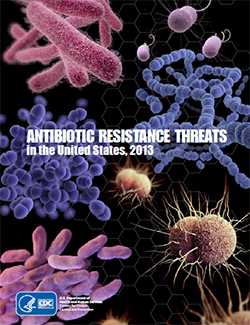Antibiotic Resistance Threats in the United States, 2013
This report, Antibiotic resistance threats in the United States, 2013 gives a first-ever snapshot of the burden and threats posed by the antibiotic-resistant germs having the most impact on human health.
Each year in the United States, at least 2 million people become infected with bacteria that are resistant to antibiotics and at least 23,000 people die each year as a direct result of these infections. Many more people die from other conditions that were complicated by an antibiotic-resistant infection.
Antibiotic-resistant infections can happen anywhere. Data show that most happen in the general community; however, most deaths related to antibiotic resistance happen in healthcare settings such as hospitals and nursing homes.
What's in the Report
Section 1: The Threat of Antibiotic Resistance [page 11]
-
Minimum Estimates of Morbidity and Mortality from Antibiotic-Resistant
Infections [page 15] -
Assessment of Domestic Antibiotic-Resistant Threats [page 20]
-
Running Out of Drugs to Treat Serious Gram-Negative Infections [page 22]
-
Developing Resistance: Timeline of Key Antibiotic Resistance Events [page 28]
Section 2: Fighting Back Against Antibiotic Resistance [page 31]
Four Core Actions to Prevent Antibiotic Resistance [page 31]
- Preventing Infections, Preventing the Spread of Resistance [page 32]
- Tracking Resistance Patterns [page 39]
- Antibiotic Stewardship: Improving Prescribing, Improving Use [page 41]
- Developing New Antibiotics and Diagnostic Tests [page 44]
Section 3: Current Antibiotic Resistance Threats in the United States,
by Microorganism page 49]
Microorganisms with a Threat Level of Urgent
- Clostridium difficile [page 51]
- Carbapenem-resistant Enterobacteriaceae [page 53]
- Drug-resistantNeisseria gonorrhoeae [page 55]
Microorganisms with a Threat Level of Serious
- Multidrug-resistant Acinetobacter [page 59]
- Drug-resistant Campylobacter [page 61]
- Fluconazole-resistant Candida (a fungus) [page 63]
- Extended spectrum β-lactamase producing Enterobacteriaceae (ESBLs) [page 65]
- Vancomycin-resistantEnterococcus (VRE) [page 67]
- Multidrug-resistant Pseudomonas aeruginosa [page 69]
- Drug-resistant non-typhoidal Salmonella [page 71]
- Drug-resistant Salmonella Typhi [page 73]
- Drug-resistant Shigella [page 75]
- Methicillin-resistant Staphylococcus aureus (MRSA) [page 77]
- Drug-resistant Streptococcus pneumoniae [page 79]
- Drug-resistant tuberculosis [page 81]
Microorganisms with a Threat Level of Concerning
Related Links
- CDC Feature: Untreatable: Today’s drug resistance health threats
- CDC Press Release: Untreatable: Report by CDC details today’s drug-resistant health threats Landmark report ranks superbugs, outlines four core actions to halt resistance
- Digital Press Kit: Untreatable: Today’s Drug-Resistant Health Threats
- CDC Antibiotic/Antimicrobial Resistance Website
- Interagency Task Force on Antimicrobial Resistance
- CDC Get Smart: Know When Antibiotics Work
- CDC Get Smart for Healthcare
- Page last reviewed: July 14, 2014
- Page last updated: April 10, 2017
- Content source:


 ShareCompartir
ShareCompartir
